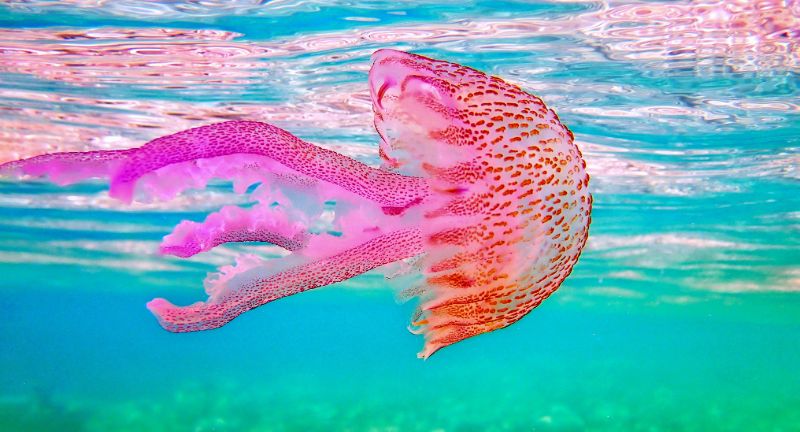NEWS
21 Mesmerizing Jellyfish Species Enigmas They Conceal
Published
2 months agoon

Jellyfish, some of the most mesmerizing creatures in the ocean, captivate us with their translucent beauty and mysterious behaviors. Each species has its own unique traits and secrets that make it an extraordinary part of the marine ecosystem. This article explores incredible jellyfish species, uncovering the fascinating details about their lives and the roles they play in the underwater world. Get ready to dive into the enchanting world of jellyfish and discover the wonders they hold.
Moon Jellyfish

Shutterstock
Moon jellyfish, known for their gentle pulsating movements, are remarkable for their adaptability to various water conditions. Found in oceans around the world, they thrive in a wide range of temperatures and salinity levels. Their ability to regenerate damaged parts also makes them resilient survivors. This species highlights the incredible adaptability of jellyfish in diverse environments.
Box Jellyfish

Shutterstock
Box jellyfish are infamous for their potent venom, which can cause severe reactions in humans. These jellyfish are also highly agile swimmers, using their complex eyes to navigate through the water. Found mainly in the Indo-Pacific, they play a significant role in maintaining ecological balance. Despite their danger, box jellyfish are a fascinating testament to nature’s power and precision.
Immortal Jellyfish

Shutterstock
The immortal jellyfish, Turritopsis dohrnii, has the unique ability to revert its cells to a juvenile state. This process, called transdifferentiation, allows it to essentially avoid aging and potentially live forever. Found in oceans worldwide, it serves as a subject of scientific research for aging and regenerative medicine. This jellyfish challenges our understanding of life and mortality.
Upside-Down Jellyfish

Shutterstock
Upside-down jellyfish live symbiotically with algae in their tentacles, relying on photosynthesis for nutrition. Found in mangroves and shallow waters, they spend most of their time resting upside-down on the seafloor. Their unique feeding strategy showcases an incredible example of mutualistic relationships in nature. These jellyfish demonstrate the interconnectedness of life in marine ecosystems.
Flower Hat Jellyfish

Shutterstock
The flower hat jellyfish is a dazzling species with luminescent, multicolored tentacles. Native to the waters off Japan, Brazil, and Argentina, it displays vibrant hues that help it camouflage among coral reefs. Its sting, though mild, is effective for capturing prey. This jellyfish species is a striking reminder of the ocean’s artistic beauty.
Lion’s Mane Jellyfish

Shutterstock
The Lion’s Mane jellyfish holds the title of the largest jellyfish species, with tentacles stretching over 100 feet. Found in cooler waters of the Atlantic and Arctic, its size is matched by its ethereal beauty. Its long tentacles not only capture prey but also provide shelter for smaller marine organisms. This species showcases the grandeur of marine life in its most majestic form.
Crystal Jellyfish

Shutterstock
The crystal jellyfish, found along North America’s Pacific coast, glows brilliantly in the dark. This bioluminescence is caused by a protein called GFP, which has become a vital tool in scientific research. With its transparent body and glowing aura, this jellyfish adds an element of magic to the underwater world. Its contributions extend beyond beauty, aiding advancements in cellular biology.
Sea Nettle Jellyfish

Shutterstock
Sea nettle jellyfish are known for their long, stinging tentacles that capture small fish and plankton. Found in both the Pacific and Atlantic oceans, their stings can cause irritation but are rarely dangerous to humans. Their striking red and gold hues make them a common sight in aquariums. These jellyfish remind us of the ocean’s delicate balance of beauty and danger.
Comb Jellies

Shutterstock
Comb jellies, although similar in appearance, are not true jellyfish. They belong to a separate phylum and use rows of cilia to move gracefully through the water. Known for their iridescent glow, they are often mistaken for bioluminescent jellyfish. These creatures illustrate the diversity within gelatinous marine life.
Portuguese Man O’ War

Shutterstock
Despite its appearance, the Portuguese Man O’ War is not a jellyfish but a siphonophore—a colony of specialized organisms. Found in warm ocean waters, it delivers a painful sting with its long, trailing tentacles. Its colorful, gas-filled float allows it to drift on ocean currents. This species highlights the complex and surprising diversity of marine life.
Spotted Lagoon Jellyfish

Shutterstock
The spotted lagoon jellyfish is a stunning species adorned with white spots on its translucent bell. Found in the Indo-Pacific region, it depends on symbiotic algae for its energy needs. Its gentle, pulsating motion makes it a favorite among divers and marine enthusiasts. This jellyfish exemplifies the intricate relationships in marine ecosystems.
Cannonball Jellyfish

Shutterstock
Cannonball jellyfish, with their round, firm bodies, are commonly found along the southeastern United States coast. They are not only admired for their appearance but are also considered a delicacy in some cultures. Their mild sting makes them less threatening compared to other species. This jellyfish highlights the culinary and ecological significance of marine life.
Deepstaria Jellyfish

Shutterstock
The Deepstaria jellyfish, a rare deep-sea species, is known for its ghostly, translucent bell. Found at depths of over 700 meters, it moves gracefully in the dark, silent waters. Its massive size and unique shape make it one of the most mysterious jellyfish species. This jellyfish symbolizes the vast unexplored depths of our oceans.
Black Sea Nettle

Shutterstock
The Black Sea Nettle is a rare and mysterious jellyfish, often referred to as the “phantom of the deep.” Found in the Pacific Ocean, its dark, purplish bell and long tentacles create an eerie yet striking presence. Despite its large size, little is known about its behavior and ecology. This jellyfish adds to the allure of the ocean’s many unexplored secrets.
Blue Blubber Jellyfish

Shutterstock
The Blue Blubber jellyfish is a vibrant species, often seen in shades of blue, purple, and white. Found in the coastal waters of Australia, this jellyfish lacks the typical long tentacles of other species. Instead, it uses its frilly oral arms to catch plankton. Its stunning appearance makes it a favorite for aquariums worldwide.
Pelagia Noctiluca

Shutterstock
Commonly known as the “mauve stinger,” Pelagia noctiluca is a bioluminescent jellyfish that lights up the night sea. Found in warm and temperate waters, its glowing display is both mesmerizing and functional, helping deter predators. Its sting, while painful, is relatively harmless to humans. This jellyfish highlights nature’s ability to merge beauty with survival.
Irukandji Jellyfish

Shutterstock
The Irukandji jellyfish, though tiny, is one of the most venomous marine creatures. Found off the coast of Australia, its sting can cause Irukandji syndrome, characterized by intense pain and potentially fatal symptoms. Despite its dangerous nature, it’s nearly invisible in the water due to its translucent body. This jellyfish reminds us of the hidden perils in the ocean.
Atolla Jellyfish

Shutterstock
The Atolla jellyfish is a deep-sea species known for its unique defense mechanism. When threatened, it emits a dazzling bioluminescent display, acting as a “burglar alarm” to attract larger predators to scare off its attacker. Found in the darkest depths of the ocean, it is a true survivor. This jellyfish demonstrates how light can be a powerful tool in the deep sea.
Pink Meanie Jellyfish

Shutterstock
The Pink Meanie jellyfish is an unusual species that preys on other jellyfish. Found in the Gulf of Mexico, it can grow massive tentacles that ensnare its victims. Its pink hue and aggressive feeding habits set it apart from other jellyfish. This species reveals the complex predator-prey dynamics in marine ecosystems.
Nomura’s Jellyfish

Shutterstock
Nomura’s jellyfish is one of the largest jellyfish species, with a bell diameter reaching up to 6 feet. Native to the waters of Japan and China, it occasionally blooms in massive numbers, causing disruptions to local fisheries. Despite its size, it shares many biological traits with smaller jellyfish. This species underscores the scale and impact of jellyfish in marine ecosystems.
Chrysaora Achlyos

Shutterstock
Chrysaora achlyos, commonly called the Black Jelly, is a rare and stunning species with a dark maroon to black bell. Found in the eastern Pacific Ocean, it’s known for its long tentacles and striking appearance. Little is known about its behavior and ecology, adding to its mystique. This jellyfish is a reminder of how much remains undiscovered in our oceans.
Conclusion

Shutterstock
From the resilient Moon jellyfish to the enigmatic Immortal jellyfish, each species reveals unique secrets about survival and adaptation. These creatures highlight the complexity and diversity of life beneath the waves. By understanding jellyfish better, we gain insights into marine ecosystems and their crucial roles. Their mysteries remind us of the vast and unexplored wonders of the ocean.
Related Topics:

More From Lifestylogy
-


23 Foods You Should Never Put In A Slow Cooker
-


22 Exercises That Make The Most Impact In Your Workout…
-


14 Items Safe for Your Extension Cord (And 9 To…
-


From Mom Rage to Resilience: 21 Tips for a Healthier…
-


20 Pieces of Parental Advice We Wish We Embraced Sooner
-


21 Phrases Child Psychologists Wish Parents & Grandparents Would Stop…
-


23 Remedies To Clear Your Sinuses And Breathe Easy Instantly
-


25 Ways to Tell You’re Raising a Dandelion Child
-


U.S. Anesthesia Partners Is Solving The Shortage Of Anesthesia Clinicians